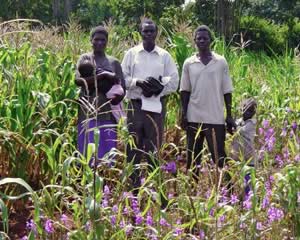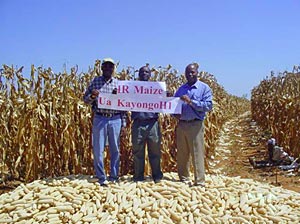CIMMYT E-News, vol 5 no. 9, September 2008
 Looks can deceive. Striga, a deadly parasitic plant, produces a lovely flower but sucks the life and yields out of crops across Africa and Asia. A new strain of improved maize seed is helping farmers reclaim their invaded crop lands.
Looks can deceive. Striga, a deadly parasitic plant, produces a lovely flower but sucks the life and yields out of crops across Africa and Asia. A new strain of improved maize seed is helping farmers reclaim their invaded crop lands.
Striga, which typically attacks cereal crops, launches its takeover from the ground up: its deadly seedlings attach to sprouting maize plants and begin siphoning off water and nutrients before either plant emerges from the soil. The parasite also poisons its host, further stifling crop development.
Worse, Striga seems to seek out the farmers least suited to control it.
“Striga thrives in low-fertility soils, which are typically owned by the poorest farmers,” says Fred Kanampiu, CIMMYT maize agronomist. National experts estimate 14% of the maize area in sub-Saharan Africa is infested with Striga, amounting to 3.64 million hectares.
Big benefits seen for Kenya
Work by a multilateral partnership has resulted in a promising Striga control measure that has recently started moving from the laboratory to farmers’ fields. The practice is based on a type of maize with a natural mutation that allows it to resist the chemical imidazolinone—active ingredient in many herbicides. Seeds of this imidazolinone-resistant (IR) maize are coated with a herbicide and, when sown, the coated seed kills sprouting Striga, allowing the crop to flourish.
“Economic studies estimate that if a third of the Striga-infested area were planted with herbicide-coated seed, benefits to farmers in Kenya would be between USD 51 million and 102 million, after production costs,” says Kanampiu, who coordinates the Striga Management Project. “This would be topped off by a yield effect of similar magnitude, because the herbicide resistance comes in seed of improved, locally-adapted varieties.”
A complex, multilateral effort
The idea of using herbicide-resistant maize to control Striga was first proposed by the Weizmann Institute of Science in Israel in the 1990s. CIMMYT worked with that organization, as well as the Kenyan Agricultural Research Institute (KARI), BASF, the African Agricultural Technology Foundation (AATF), non-governmental organizations, and seed companies including Pioneer to develop, evaluate, and spread the practice, particularly among small-scale farmers for whom other control methods, such as spraying, are expensive or impractical. A key part of the work involved developing high-yielding, locally-adapted maize varieties that were also herbicide tolerant. The coating method was fine-tuned by Weizmann and the company Hi-Cap Formulations.
Support for more recent tests and promotion came from the German Federal Ministry for Economic Cooperation and Development (BMZ), the International Fund for Agricultural Development (IFAD), and the Rockefeller Foundation. By 2006 CIMMYT and KARI scientists had provided almost 300 herbicide-tolerant maize varieties for regional testing. Studies in randomly-selected farmers’ fields showed that with 30 grams (a little more than 1 ounce) of imazapyr herbicide per hectare as a seed coat in heavily infested fields, Striga was reduced by 81% and farmers enjoyed a 63% net return.

Striga meets its match
“The IR-maize reduces the Striga seed bank in the soil, lessening the need for future Striga control measures,” says Gospel Omanya, a Stewardship Manager from AATF, which is leading region-wide public awareness campaigns, field testing, and risk assessment. In addition, smallholder farmers who have tested the new maize and seed-coating practice on their land have obtained as much as a five-fold increase in grain yield.
Positive results like these led to the release of five IR varieties to farmers in Kenya, and nine other varieties are in performance evaluations for eventual release in Tanzania and Uganda.
More than 50,000 packages of IR-maize seed were distributed to farmers at 140 locations in Kenya for comparison with other Striga control practices. AATF surveyed more than 5,000 farmers and found they overwhelming favored the IR-maize seed. At least 10 seed companies, including Western Seed Company in Kenya and Tanseed International in Tanzania, are using IR maize and 60 tons of certified seed were marketed during 2007-2008.
“It was years of intense research and collaboration between partners dedicated to a unified objective, in addition to a willingness to invest human and financial resources, that allowed this concept to become a reality,” says Kanampiu. “The practice offers real, life-changing benefits for subsistence farmers like many in western Kenya, who tend 1.5 hectare plots of mostly maize just to feed their families. Their crops are normally so decimated by Striga that they harvest barely enough.”
Meanwhile, CIMMYT is working with the International Institute of Tropical Agriculture (IITA), a leader in the effort to identify and breed maize strains that contain genetic resistance to Striga. The aim is to offer farmers yet another way of controlling this lovely but lethal pest.
For more information, contact Fred Kanampiu (f.kanampiu@cgiar.org).
 Nutrition, health and food security
Nutrition, health and food security 
